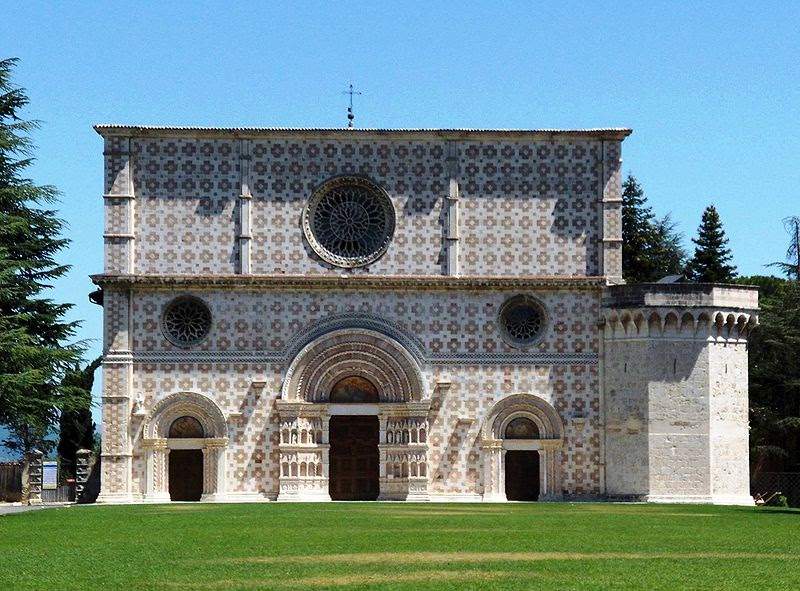The restoration of the Basilica of Collemaggio (L'Aquila) among the winners of the Europa Nostra Award 2020
There is also the restoration of the Basilica of Collemaggio (L’Aquila) among the winners of the 2020 edition of theEuropa Nostra Award, Europe’s largest prize dedicated to the preservation of cultural heritage. For the Conservation category, the L’Aquila restoration is among the eight awardees. The other seven winning restorations are those of: Rubenshuis (Antwerp, Belgium), Hvar Arsenal (Croatia), Epitaphs of the Paulinerkirche (Leipzig, Germany), Museum of Fine Arts Budapest (Hungary), LocHal (Tilburg, Netherlands), El Cotarro Caves (Burgos, Spain), Iron Bridge (Shropshire, UK).
The restoration of the Basilica of Collemaggio was entirely supervised by the Soprintendenza Archeologia, Belle Arti e Paesaggio for L’Aquila and crater, both for the design and the direction of the work (entrusted to architect Antonello Garofalo and art historian Biancamaria Colasacco). The study, analysis and design phase was carried out with the support of authoritative experts from three Italian universities: the Politecnico di Milano, the University of Rome La Sapienza and the University of L’Aquila coordinated by Professors Stefano Della Torre, Giovanni Carbonara and Dante Galeota, respectively. The intervention, which was entirely supported by Eni and made use of the operational expertise of the ARCAS company of Turin, involved a symbolic place in the city, devastated by the 2009 earthquake, with complex consolidation, reconstruction and restoration work completed in just two years. Years of work led to the reopening of the Basilica on December 20, 2017, in the presence of Cultural Heritage Minister Dario Franceschini. The work took place in a constant dialogue between the Ministry of Cultural Heritage and Activities and Tourism (MiBACT), the Diocese and the Municipality of L’Aquila, which had signed the sponsorship agreement with Eni S.p.A. in 2013.
This collaboration was also underscored in the motivation for the Prize, which highlighted the fact that the restoration “builds on a public-private agreement, and saw the involvement of three universities with an exemplary scientific study. [...] The multidisciplinary approach [...] is a true model,” and “the project stands out as a paradigm of good practice to be followed in the conservation of severely damaged sites around the world.”
The Basilica of Collemaggio is now also in the running for the Public Choice Award, the prize given to the public’s favorite project. People throughout Europe and the rest of the world can vote online, at https://vote.europanostra.org/, for their favorite project, and help decide which of the awardees will go for this year’s Public Choice Award. In this time of social isolation and distancing, the European Commission and Europa Nostra hope to encourage as many people as possible to appreciate the achievements of this year’s winning projects and to share the names of their three favorites. The Public Choice Award will be announced after the summer.
“This important award,” says Superintendent Alessandra Vittorini, “is the prize to a choral work, to a difficult challenge won thanks to the commitment of many, which has given back to the city its symbol of art and faith. It is a milestone in the recovery of the city’s entire cultural heritage, which, day by day, is reassembling its image in an extraordinary and surprising picture. After the recent inscription of the Perdonanza Celestiniana in the UNESCO Intangible Heritage List, today the recovery of the Basilica, ’home’ of the Perdonanza for more than seven centuries, is recognized as a European example of ”good practice“: a scientific and rigorous restoration, capable of building community cohesion and belonging, a driving element of the post-earthquake rebirth. It is to all the protagonists of this extraordinary path of reconstruction (of the Basilica, but also of the entire city) that we dedicate this award.”
“Two years after the reopening ceremony of the splendid Basilica of Santa Maria di Collemaggio, which was half-destroyed by the earthquake of April 6, 2009 and rebuilt in just two years,” says Minister Franceschini, “this European award once again confirms our country’s great expertise in the field of protection. It is a source of pride and an important recognition for all those who have worked hard and silently in recent years to return an important indentitarian symbol to the entire community. To them goes my personal thanks.”
“In these difficult times,” says Hermann Parzinger, executive chairman of Europa Nostra, “our winners, with their stories of how adversity can be overcome through professionalism, commitment, and teamwork, represent true spokesmen for hope. These exemplary-value projects demonstrate that cultural heritage is critical in the process of physical and mental recovery from the trauma caused by the pandemic. Our shared heritage, and those who care for it, can contribute in so many ways: from sharing cultural content through innovative digital solutions, to implementing recovery and restoration work that represent opportunities for economic and social revival for our cities and towns.”
The European Heritage Awards / Europa Nostra Awards were initiated by the European Commission in 2002 and have since been managed by Europa Nostra - the European Voice of Civil Society Committed to Cultural Heritage. The Awards are supported by the European Union’s Creative Europe program. Winners were selected by juries made up of heritage experts from across Europe, based on a thorough evaluation of applications from organizations and individuals from 30 European countries. The juries also decided to award three Europa Nostra Prizes to three outstanding projects promoted by European nations not taking part in the EU Creative Europe program, namely Switzerland and Turkey. The list of winners can be found on the Europa Nostra website.
 |
| The restoration of the Basilica of Collemaggio (L'Aquila) among the winners of the Europa Nostra Award 2020 |
Warning: the translation into English of the original Italian article was created using automatic tools. We undertake to review all articles, but we do not guarantee the total absence of inaccuracies in the translation due to the program. You can find the original by clicking on the ITA button. If you find any mistake,please contact us.





























